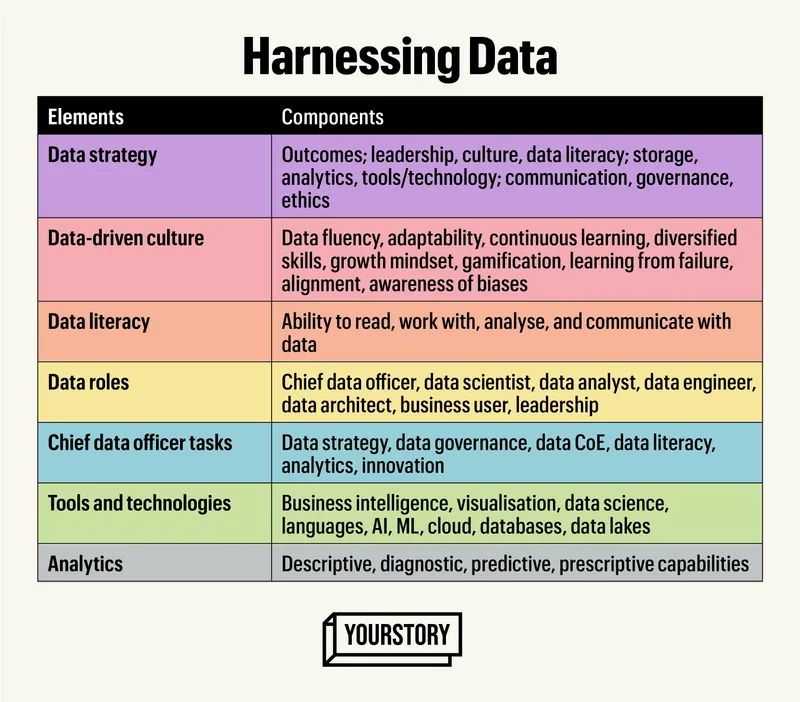Data literacy, culture, strategy – how to succeed as a data-driven organisation
Data, decisions, and democratisation of access represent the cutting edge of digital transformation, as this book explains. Here are some key takeaways and tips.
Launched in 2012, YourStory's Book Review section features over 355 titles on creativity, innovation, entrepreneurship, and digital transformation. See also our related columns The Turning Point, Techie Tuesdays, and Storybites.
Data-driven teams and organisations play an increasing role in business success for startups and large firms. Frameworks and tips on harnessing the digital advantage are explained in the new book, Be Data Driven: How Organisations Can Harness the Power of Data by Jordan Morrow.
Based in Utah, Jordan Morrow is VP and Head of Data and Analytics at BrainStorm, and is regarded as a pioneer in the field of data literacy. He served as the Chair of the Advisory Board for The Data Literacy Project. His earlier book is Be Data Literate, and he is also an ultra-marathoner.
Jordan’s new book is well structured and backed with five pages of references. But some of the material gets a bit repetitive, and the addition of more concrete examples could have helped strengthen the frameworks and arguments.
Here are my key takeaways from the 220-page book, summarised as well in the table below. See also my reviews of the related books Data Strategy, Platform Strategy, Platform Scale, Winning in the Digital Age, Seeing Digital, and Machine, Platform, Crowd.

I. Foundations
The world is becoming increasingly data-driven, the author begins, pointing to the rise of smartphones, IoT, wearables, social media, smart homes, and connected vehicles.
Data can be empowering to consumers, employees, and businesses. To be successful, organisational data strategy must support the overall business strategy.
However, many organisations have wrongly assumed that data strategy is largely about buying technology and hiring chief data officers, Jordan cautions. The pandemic has accelerated the importance of remote work and data, while also exposing business gaps in data literacy and effective leadership.
“The pandemic was one of the greatest illustrative examples of the need for data literacy,” Jordan affirms. “While the nature of shutdowns varies across the world, the need for and use of data is paramount and universal,” he adds.
Business intelligence tools help democratise data to the masses. Democratising data is a powerful way to get more eyes, ears, and voices into the data," Jordan explains. AI and ML help in preparing, processing, automation, visualisation, and prediction tasks, and enable humans to do higher-order work.

Workforces need to be data literate and progress to data fluency. They need continuous upskilling (to do the job better) or reskilling (to do new jobs). Data literacy empowers employees to make smarter, evidence-based decisions.
The author makes distinctions between the focus areas of data scientists (modeling, statistics), data analysts (business decisions), and data engineers (systems). All employees are eventually responsible for descriptive and diagnostic analytics, while predictive and prescriptive analytics should be owned by advanced organisational roles.
Strategy consists of desired states, directions, and actions. Culture is defined by rituals, routines, traditions, beliefs, and organisational personality.
Data-driven organisations have clear alignment between business strategy and data strategy, with leadership support, data literate workforce, and infrastructure. There should be a balance between experience-driven and data-driven decisions, between human and machine, Jordan advises.
For example, at Amazon, the culture is defined by metrics, leadership is involved in data-driven decisions, and the company has democractised data access. Starbucks leverages its app data to make recommendations and design targeted campaigns.
Airbnb creates personalised travel options based on data. Pepsico’s supply chain was reconfigured using data insights during the pandemic. Flatiron Health leverages data points to enhance research and care for cancer patients.

II. Gaps in data strategy
One section of the book identifies gaps in the way of becoming a data-driven organisation, and ways to overcome these shortcomings.
Data literacy gaps can be improved through persona-based learning programmes, iterative capacity building, cohorts, and roping in evangelists and ambassadors. Data silos should be overcome so as to assist better data integration.
Leaders should invest in all elements of organisational data strategy, take personal ownership, communicate the data vision, drive change management, and democratise decision making. They should engage in creative as well as critical thinking.
“Unless ethics is a priority on the CEO’s agenda, negligence can result in reputational consequences or even shutdown of the business,” Jordan cautions.
Commitment to ethical use of data can also be turned into competitive advantage. Data governance should cover issues of security, trust, privacy, consistency, usability, standards, and policies.
The biggest hurdle to data strategy is organisational culture, Jordan observes. Skills, fluency, and adaptability are key in this regard. “Everyone has a place at the data-driven table,” Jordan emphasises, making the case for diversity of representation and inputs.
Biases (eg. selection, confirmation) can creep in. Employees should not fear failure or its repercussions in their data journeys. Failure should be celebrated and utilised for learning, the author advises. Communities of interest and practice should flourish.

III. Implementation
The last section describes the stages of building the data-driven organisation: assessing the current situation, deciding outcomes, getting the right people involved, having planning meetings, communicating the vision, and ensuring alignment.
Large outcomes should also factor in a series of smaller wins along the way, rather than trying to “boil the ocean” at once. Elements of iteration, revision, and refinement should be included as well, and there is no real hard finishing line.
Ultimately, value should be brought to the data, and insights should be brought to the forefront of the workforce. “Analytical processes and methodologies are the things that will wake the data giant and put it to work,” Jordan affirms.

The road ahead
Data should ultimately drive decisions. In this regard, Jordan cites the framework of Kevin Hanegan (author of Turning Data into Wisdom): ask, acquire, analyse, apply, announce, and assess the decision.
“COVID-19 has sped up the data-driven world, regardless of region or industry,” Jordan affirms.
Drawing on the analogy of running an ultra-marathon, he advises leaders to maintain their pace and not try to run too fast in the data journey. Learning and skills are equivalent to fuel and training in this race.
“Data and analytics present such a powerful moment and opportunity for individuals and organisations,” Jordan signs off.
YourStory has also published the pocketbook ‘Proverbs and Quotes for Entrepreneurs: A World of Inspiration for Startups’ as a creative and motivational guide for innovators (downloadable as apps here: Apple, Android).
Edited by Teja Lele











